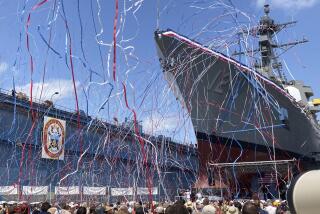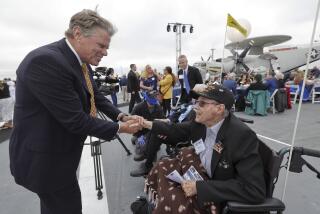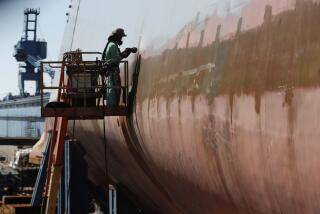Retired rear admiral revolutionized Navy’s air-defense weapon system
- Share via
Retired Rear Adm. Wayne E. Meyer, who was known as the “Father of Aegis,” the Navy’s primary air-defense weapon system that revolutionized how the Navy performed air defense, has died. He was 83.
Meyer, who managed the development and early building of the Aegis system and later had an Aegis-equipped destroyer named after him, died of heart failure Tuesday at a hospital in Washington, D.C., said his son James.
Meyer had been director of engineering at the Naval Ship Missile Systems Engineering Station in Port Hueneme before he was recalled to Washington and reported to the Naval Ordnance Systems Command as Aegis Weapon System manager in 1970.
Meyer was promoted to rear admiral in 1975, the same year he became the founding project manager of Aegis shipbuilding.
The shipboard missile-guidance system -- the first engineering model was installed in a test ship in 1973 -- uses sophisticated computers and a powerful phased-array radar to track more than 100 targets and launch missiles to destroy them.
Named for the shield of the Greek god Zeus, Aegis has been described as the first totally integrated air weapon system in the history of the Navy and the world’s preeminent maritime combat system.
The first Aegis-equipped cruiser, Ticonderoga, was commissioned in 1983. And, in 1991, the first Aegis destroyer, Arleigh Burke, was commissioned.
Today, the Navy operates 54 Aegis destroyers and 22 Aegis cruisers.
“Similar to [Adm. Hyman] Rickover and his long-term persistence in overcoming all the obstacles to make the nuclear Navy happen, Meyer basically overcame the same sort of obstacles, provided the guidance -- the wisdom, if you will -- and the determination to make it happen,” said Bob Harney, associate professor of systems engineering at the Naval Postgraduate School in Monterey, Calif., where the systems engineering institute is named after Meyer.
Facing budgetary concerns, technical problems and “a huge amount of politics,” Meyer above all provided leadership, Harney said.
“He led the way,” Harney said. “He was out front of everything, and people worked to try to keep up with him.”
In 1983, Meyer was reassigned as deputy commander of the Naval Sea Systems Command’s Weapons and Combat Systems; he retired from active duty in 1985.
In honor of Meyer’s work on the Aegis weapon system, the Navy announced in 2006 that it would name its newest Arleigh Burke-class guided-missile destroyer after him.
Two years later, Meyer proudly looked on as his wife, Anna Mae, christened the destroyer bearing his name with a bottle of champagne at the Bath Iron Works shipyard in Maine.
A crowd of more than 1,500 turned out for the christening, where U.S. Sen. Susan Collins (R-Maine), one of the speakers, described Meyer as a “living legend, a patriot and a visionary.”
Meyer was born April 21, 1926, in Brunswick, Mo. He graduated from the University of Kansas with a bachelor’s degree in electrical engineering in 1946.
He later earned a master’s in astronautics and aeronautics at the Massachusetts Institute of Technology, and a bachelor’s degree in electrical engineering at the Naval Postgraduate School.
Meyer, who had enlisted in the Navy Reserve in 1943 at age 17, was commissioned an ensign in the Navy Reserve in 1946 and was transferred to the regular Navy two years later.
In the early 1950s, he attended the Joint Guided Missile School and Naval Line School, and eventually was an instructor at the Special Weapons School in Norfolk, Va.
He was a commander when Navy Secretary Fred Korth selected him to serve in the Navy Task Force for Surface Guided Missile Systems in 1963.
Meyer was known for several sayings that became his trademarks: “Build a little, test a little, learn a lot”; “Whatever you do, do it the best you can”; and “We ain’t done yet.”
After retiring from active duty, Meyer ran his own management and consulting business for the Navy.
His first wife, Margaret, predeceased him.
In addition to his wife Anna Mae and his son James, Meyer is survived by another son, Robert; a daughter, Paula Meyer; two stepchildren, Anna and Eddie; and four grandchildren.
--
More to Read
Sign up for Essential California
The most important California stories and recommendations in your inbox every morning.
You may occasionally receive promotional content from the Los Angeles Times.













